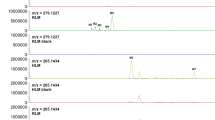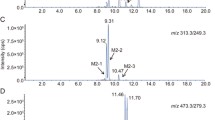Abstract
Objective: The purpose of the present study was to elucidate the cytochrome P450 (P450) isoform(s) involved in the metabolism of loperamide (LOP) to N-demethylated LOP (DLOP) in human liver microsomes. Methods: Three established approaches were used to identify the P450 isoforms responsible for LOP N-demethylation using human liver microsomes and cDNA-expressed P450 isoforms: (1) correlation of LOP N-demethylation activity with marker P450 activities in a panel of human liver microsomes, (2) inhibition of enzyme activity by P450-selective inhibitors, and (3) measurement of DLOP formation by cDNA-expressed P450 isoforms. The relative contribution of P450 isoforms involved in LOP N-demethylation in human liver microsomes were estimated by applying relative activity factor (RAF) values. Results: The formation rate of DLOP showed biphasic kinetics, suggesting the involvement of multiple P450 isoforms. Apparent Km and Vmax values were 21.1 μM and 122.3 pmol/min per milligram of protein for the high-affinity component and 83.9 μM and 412.0 pmol/min per milligram of protein for the low-affinity component, respectively. Of the cDNA-expressed P450 s tested, CYP2B6, CYP2C8, CYP2D6, and CYP3A4 catalyzed LOP N-demethylation. LOP N-demethylation was significantly inhibited when coincubated with quercetin (a CYP2C8 inhibitor) and ketoconazole (a CYP3A4 inhibitor) by 40 and 90%, respectively, but other chemical inhibitors tested showed weak or no significant inhibition. DLOP formation was highly correlated with CYP3A4-catalyzed midazolam 1-hydroxylation (rs=0.829; P<0.01), CYP2B6-catalzyed 7-ethoxy-4-trifluoromethylcoumarin O-deethylation (rs=0.691; P<0.05), and CYP2C8-catalyzed paclitaxel 6α-hydroxylation (rs=0.797; P<0.05). Conclusion: CYP2B6, CYP2C8, CYP2D6, and CYP3A4 catalyze LOP N-demethylation in human liver microsomes, and among them, CYP2C8 and CYP3A4 may play a crucial role in LOP metabolism at the therapeutic concentrations of LOP. Coadministration of these P450 inhibitors may cause drug interactions with LOP. However, the clinical significance of potential interaction of LOP metabolism by CYP2C8 and CYP3A4 inhibitors should be studied further.




Similar content being viewed by others
Abbreviations
- P450:
-
Cytochrome P450
- LOP:
-
Loperamide
- DLOP:
-
Desmethylloperamide
- 7-EFC:
-
7-Ethoxy-4-trifluoromethylcoumarin
- DDC:
-
Diethyldithiocarbamate
References
Camilleri M (1998) Therapeutic approach to the patient with irritable bowel syndrome. Am J Med 107:27S–32S
Sach JA, Chang L (2002) Irritable bowel syndrome. Curr Treat Options Gastroenterol 5:267–278
Fogel R (2001) Fecal incontinence. Curr Treat Options Gastroenterol 4:261–266
Schiller LR (2003) Treatment of fecal incontinence. Curr Treat Options Gastroenterol 6:319–327
De Haven-Hudkins DL, Cowan A, Cortes Burgos L, Daubert JD, Cassel JA, DeHaven RN, Kehner GB, Kumar V, Park-Wyllie LY, Antoniou T (2002) Antipruritic and antihyperalgesic actions of loperamide and analogs. Life Sci 71:2787–2796
De Haven-Hudkins DL, Burgos LC, Cassel JA, Daubert JD, DeHaven RN, Mansson E, Nagasaka H, Yu G, Yaksh T (1999) Loperamide (ADL 2-1294), an opioid antihyperalgesic agent with peripheral selectivity. J Pharmacol Exp Ther 289:494–502
Schinkel AH, Wagenaar E, Mol CA, van Deemter L (1996) P-glycoprotein in the blood-brain barrier of mice influences the brain penetration and pharmacological activity of many drugs. J Clin Invest 97:2517–2524
Sadeque AJ, Wandel C, He H, Shah S, Wood AJ (2000) Increased drug delivery to the brain by P-glycoprotein inhibition. Clin Pharmacol Ther 68:231–237
Eneroth A, Astrom E, Hoogstraate J, Schrenk D, Conrad S, Kauffmann HM, Gjellan K (2001) Evaluation of a vincristine resistant Caco-2 cell line for use in a calcein AM extrusion screening assay for P-glycoprotein interaction. Eur J Pharm Sci 12:205–214
Wandel C, Kim R, Wood M, Wood A (2002) Interaction of morphine, fentanyl, sufentanil, alfentanil, and loperamide with the efflux drug transporter P-glycoprotein. Anesthesiology 96:913–920
Miyazaki H, Nambu K, Matsunaga Y, Hashimoto M (1979) Disposition and metabolism of [14C]loperamide in rats. Eur J Drug Metab Pharmacokinet. 4:199–206
Yoshida K, Nambu K, Arakawa S, Miyazaki H, Hashimoto M (1979) Metabolites of loperamide in rats. Biomed Mass Spectrom 6:253–259
He H, Sadeque A, Erve JC, Wood AJ, Hachey DL (2000) Quantitation of loperamide and N-demethyl-loperamide in human plasma using electrospray ionization with selected reaction ion monitoring liquid chromatography-mass spectrometry. J Chromatogr B Biomed Sci Appl 744:323–331
Tayrouz Y, Ganssmann B, Ding R, Klingmann A, Aderjan R, Burhenne J, Haefeli WE, Mikus G (2001) Ritonavir increases loperamide plasma concentrations without evidence for P-glycoprotein involvement. Clin Pharmacol Ther 70:405–414
Park JY, Kim KA, Kim SL (2003) Chloramphenicol is a potent inhibitor of cytochrome P450 isoforms CYP2C19 and CYP3A4 in human liver microsomes. Antimicrob Agents Chemother 47:3464–3469
Kim KA, Park JY (2003) Inhibitory effect of glyburide on human cytochrome p450 isoforms in human liver microsomes. Drug Metab Dispos 31:1090–1092
Park JY, Kim KA (2003) Inhibitory effect of 5-fluorouracil on human cytochrome P(450) isoforms in human liver microsomes. Eur J Clin Pharmacol 59:407–409
Eagling VA, Tjia JF, Back DJ (1998) Differential selectivity of cytochrome P450 inhibitors against probe substrates in human and rat liver microsomes. Br J Clin Pharmacol 45:107–114
Pearce R, Greenway D, Parkinson A (1992) Species differences and interindividual variation in liver microsomal cytochrome P4502A enzymes: effect on coumarin, dicumarol and testosterone oxidation. Arch Biochem Biophys 298:211–225
Kobayashi K, Abe S, Nakajima M, Shimada N, Tani M, Chiba K, Yamamoto T (1999) Role of human CYP2B6 in S-mephobarbital N-demethylation. Drug Metab Dispos 27:1429–1433
Rahman A, Korzekwa KR, Grogan J, Gonzales FJ, Harris JW (1994) Selective biotransformation of Taxol to 6-alpha hydroxy Taxol by human cytochrome P450 2C8. Cancer Res 54:5543–5546
Newton DJ, Wang RW, Lu AY (1995) Cytochrome P450 inhibitors. Evaluation of specificities in the in vitro metabolism of therapeutic agents by human liver microsomes. Drug Metab Dispos 23:154–158
Ko JW, Sukhova N, Thacker D, Chen P, Flockhart DA (1997) Evaluation of omeprazole and lansoprazole as inhibitors of cytochrome P450 isoforms. Drug Metab Dispos 25:853–862
Nakajima M, Nakamura S, Tokudome S, Shimada N, Yamazaki H, Yokoi T (1999) Azelastine N-demethylation by cytochrome P-450 (CYP)3A4, CYP2D6, and CYP1A2 in human liver microsomes: evaluation of approach to predict the contribution of multiple CYPs. Drug Metab Dispos 27:1381–1391
Stormer E, von Moltke LL, Greenblatt DJ (2000) Scaling drug biotransformation data from cDNA-expressed cytochrome P-450 to human liver: a comparison of relative activity factors and human liver abundance in studies of mirtazapine metabolism. J Pharmacol Exp Ther 295:793–801
Venkatakrishnan K, von Moltke LL, Court MH, Harmatz JS, Crespi CL, Greenblatt DJ (2000) Comparison between cytochrome P450 (CYP) content and relative activity approaches to scaling from cDNA-expressed CYPs to human liver microsomes: ratios of accessory proteins as sources of discrepancies between the approaches. Drug Metab Dispos 28:1493–1504
Rochat B (2003) Evaluation of recombinant cytochromes P450 activity in metabolic pathways. Drug Metab Dispos 31:145–146
Crespi CL (1995) Xenobiotic-metabolizing human cells as tools for pharmacological and toxicological research. Adv Drug Res 26:179–235
Venkatakrishnan K, von Moltke LL, Greenblatt DJ (1998) Human cytochromes P450 mediating phenacetin O-deethylation in vitro: validation of the high-affinity component as an index of CYP1A2 activity. J Pharm Sci 87:1502–1507
Hijazi Y, Boulieu R (2002) Contribution of CYP3A4, CYP2B6, and CYP2C9 isoforms to N-demethylation of ketamine in human liver microsomes. Drug Metab Dispos 30:853–858
Oda Y, Hamaoka N, Hiroi T, Imaoka S, Hase I, Tanaka K, Funae Y, Ishizaki T, Asada A (2001) Involvement of human liver cytochrome P4502B6 in the metabolism of propofol. Br J Clin Pharmacol 51:281–285
Sai Y, Dai R, Yang TJ, Krausz KW, Gonzalez FJ, Gelboin HV, Shou M (2000) Assessment of specificity of eight chemical inhibitors using cDNA-expressed cytochromes P450. Xenobiotica 30:327–343
Kumar GN, Dykstra J, Roberts EM, Jayanti VK, Hickman D, Uchic J, Yao Y, Surber B, Thomas S, Granneman GR (1999) Potent inhibition of the cytochrome P-450 3A-mediated human liver microsomal metabolism of a novel HIV protease inhibitor by ritonavir: a positive drug-drug interaction. Drug Metab Dispos 27:902–908
Park-Wyllie LY, Antoniou T (2003) Concurrent use of bupropion with CYP2B6 inhibitors, nelfinavir, ritonavir and efavirenz: a case series. AIDS 17:638–640
Kim KA, Park JY, Lee JS, Lim S (2003) Cytochrome P450 2C8 and CYP3A4/5 are involved in chloroquine metabolism in human liver microsomes. Arch Pharm Res 26:631–637
Stormer E, Brockmoller J, Roots I, Schmider J (2000) Cytochrome P-450 enzymes and FMO3 contribute to the disposition of the antipsychotic drug perazine in vitro. Psychopharmacology 151:312–320
Acknowledgements
We thank Dr. Meuldermans (Jassen Research Foundation, Beerse, Belgium) for the generous supply of the metabolite of loperamide.
Author information
Authors and Affiliations
Corresponding author
Rights and permissions
About this article
Cite this article
Kim, KA., Chung, J., Jung, DH. et al. Identification of cytochrome P450 isoforms involved in the metabolism of loperamide in human liver microsomes. Eur J Clin Pharmacol 60, 575–581 (2004). https://doi.org/10.1007/s00228-004-0815-3
Received:
Accepted:
Published:
Issue Date:
DOI: https://doi.org/10.1007/s00228-004-0815-3




